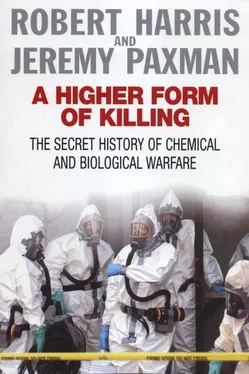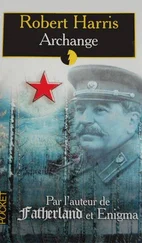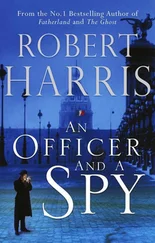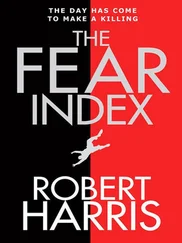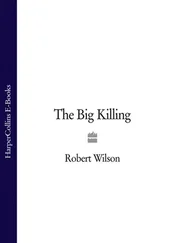Long after the initial bombardment had occurred, an area which had been contaminated by mustard was liable to remain dangerous. The liquid formed pools in shell craters and in the corners of dug-outs ready to trap the unwary. It polluted water. In cold weather it froze like water and stayed in the soil: mustard used in the winter of 1917 poisoned men in the spring of 1918 when the ground thawed. In this way, mustard could be used to ‘seal off’ whole areas of a battlefield; the only way to cross a contaminated section of ground was by laying a road of bleach. To survive such conditions, men not only had to wear masks, but also leggings, gloves and goggles. To continue to fight it was necessary to decontaminate equipment constantly. Gas became a weapon of attrition: its military effectiveness was not only measured merely in casualty lists. If gas never killed a man, wrote General Fries, head of the infant United States Chemical Warfare Service, ‘the reduction in physical vigour and, therefore, in efficiency of an army forced at all times to wear masks, would amount to at least 25 per cent, equivalent to disabling a quarter of a million men out of an army of a million.’ 41
For the average soldier, the strain of living in this alien, chemically-polluted environment was scarcely bearable. Even the well-disciplined made mistakes. Among the rest – the shell-shocked, the careless, the raw and frightened conscripts – gas mopped up casualties. ‘After July 1917,’ wrote Lord Moran, ‘gas partly usurped the role of high explosive in bringing to a head a natural unfitness for war. The gassed men were an expression of trench fatigue, a menace when the manhood of the nation had been picked over.’ 42
Mustard went under a variety of different names. To the Germans it was ‘Lost’, to the French ‘Yperite’, after Ypres, where it was first used; the British also code-named it HS (‘Hun Stuff’). Its chemical name was dichlorethyl sulphide – a substance the British had actually turned down when it was suggested as a weapon on the grounds that it wasn’t sufficiently lethal. They now had cause bitterly to regret that decision. It had taken the Germans only six months to get the gas into production. It took the French until June 1918 – almost a year. The British encountered even more difficulties in setting up bulk production. Not only was the chemical process required extremely complicated, it also proved highly dangerous.
The main English plant – capable of producing over twenty tons a day – was eventually sited at Avonmouth. Among its 1,100 workers, its Medical Officer reported in December 1918 that there had been over 1,400 illnesses directly attributable to the work. 43In addition there were 160 accidents and over a thousand burns; three people were killed and another four had died of related illnesses in the six months that the factory was in operation. There were a vast number of complaints – blisters of the hands, scalp, shoulders, arms, abdomen, buttocks, genitals, thighs, legs and feet; erythema, iritis, scrotal dermatitis, leukodermia, conjunctivitis, pharyngitis, bronchitis, tracheitis, gastritis, pleurodynia, purulent broncho-pneumonia, aphonia, acute rhinitis (bleeding from the nose); debility, gastric pain, mental inertia, chronic cough, breathlessness, memory weakness and defective eyesight. Many of the workers were old, many were women – some pregnant. There were thirty resident patients in the factory hospital, tended by a doctor and eight nurses. All in all, it added a new meaning to the phrase ‘the Home Front’. Yet despite the frenzied efforts to produce British mustard gas, no supplies reached the battlefield until September 1918, two months before the Armistice.
Instead the British responded with a series of major cloud gas attacks – the last of the war – using cylinders of phosgene mounted on the backs of railway engines. Foulkes, who dreamt up the idea, called them ‘beam’ operations – concentrated clouds which drifted in thin columns over the enemy positions, bleaching vegetation for distances of up to 12,000 yards; at Ypres the clouds accumulated in the river valleys for hours.
The attacks caused panic among billeted soldiers in villages and towns many miles behind the lines. When a cloud was detected approaching (invariably at night) alarm bells were rung and troops and civilians, all clutching respirators, made their way to the top rooms of the houses, closing all the windows and doors. The cloud swirled by below, killing all the flowers and vegetables in the gardens. The attacks, reaching far behind the lines and for the first time affecting large numbers of civilians, were greatly feared. The Germans were so anxious to avoid revealing the casualties they incurred that – according to Foulkes – ‘the greatest secrecy was always observed… and all burials and evacuations were carried out at night.’ 44
They were dangerous and difficult attacks to mount. Captain A. E. Hodgkin, commander of the Special Brigade’s ‘A’ Company, left behind in his diary a striking account of what life was like in the closing months of the war: working close to the front line in the early hours of the morning, in a ‘very cold and high wind’, the night moonless and pitch-black, trying to manhandle tons of liquid phosgene ‘brought up the line by light railway which is never repaired much and which is consequently jerky, to say the least of it. Each truck goes up separately being pushed by five or six men: every 100 yards or so it hops off the line and has to be unloaded, replaced on the line and loaded up again. My vocabulary has been improved wonderfully by the exercise, but that of the men is becoming rather threadbare.’ 45
Night after night, the men of ‘A’ Company would stand by to release the gas – Hodgkin by a field telephone in a tunnel full of a ‘multitude of fungi and rats’ – only to be told as dawn was breaking to forget it until the next night. Often the German sentries a few hundred yards away heard them moving about and passed word to their artillery. On one occasion, Hodgkin was stranded at the front in a heavy bombardment:
The night was still uncannily quiet until 2 am when we started our return journey. When halfway down the light railway the enemy began shelling with gas shells. I have never heard so many in the air at once. So we took shelter in one of the reserve lines for about an hour and a half, by which time he seemed to have finished with Cambrin through which we had to pass. Just at this time we saw our S.O.S. signal go up and a battle begin to the north of the Canal. Then down came a barrage of gas and high explosive all along the La Bassee road. I don’t know how any of us ever got back at all: we had to march all the way back to Sailly in respirators as the whole area was soaked with gas, and were pursued the entire distance with shells of all calibres.
Eventually, after weeks of waiting, Hodgkin was given the order to release the gas. The cylinders were mounted on the backs of ten 10 ton trucks, towed by four engines to within 700 yards of the German Front line. At 1 am, in bright moonlight, Hodgkin watched apprehensively as the first waves of the gas drifted towards enemy positions where the night before a patrol had reported that ‘loud talking and laughing could be heard at 4 am’. The discharge lasted over three hours. Hodgkin had little idea – apart from ‘a good deal of promiscuous shelling in retaliation’ – of what effect the attack was having. The only accurate casualty report he received was when he returned to base to be told that he had ‘killed three of our own men, poor devils, who hadn’t been warned by their officer to be clear of the danger area by zero time.’
Despite the riskiness of railway-mounted operations from behind the front lines, in March 1918 Foulkes was putting the final touches to what would have been the biggest cylinder discharge of all time, so great that, in his opinion, ‘trench warfare would have been converted into open warfare in a day’. 200,000 cylinders of phosgene were to be opened from the backs of dozens of railway trains, releasing 6,000 tons of gas in a chemical offensive which would last for twelve hours. Few respirators – even twenty or thirty miles behind the front line – would be able to withstand such an onslaught. Casualties were estimated to be likely to be 50 per cent. In the ensuing confusion the British High Command planned to launch a mighty offensive, spearheaded by tanks, which would punch its way through the front and end the war. The sector of the front provisionally selected for the attack was that held by the 3rd Army, between Gavrelle and Gouzeaucourt.
Читать дальше
